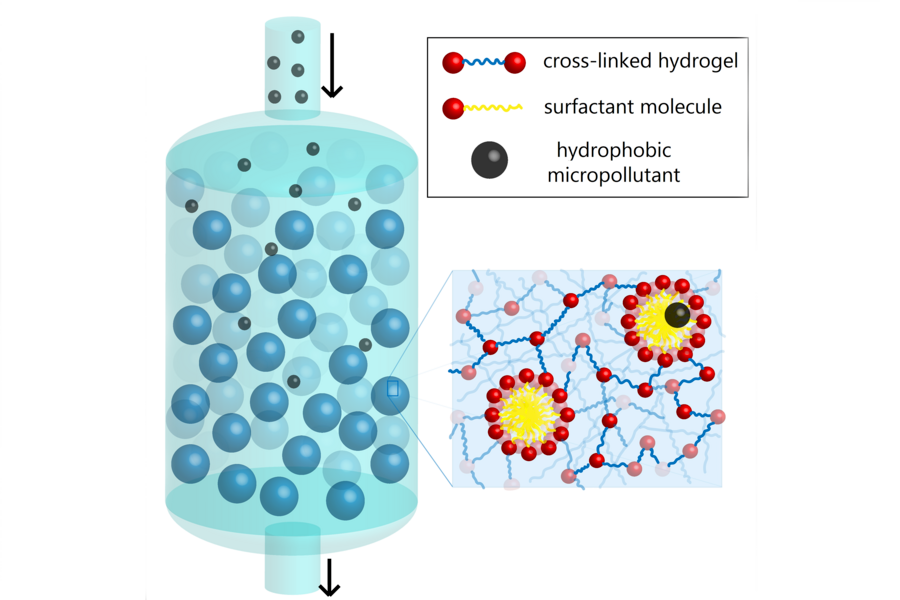Micropollutants are present in the environment all around us and are a growing concern as they are notoriously difficult to remove with the methods available today. This is of concern in aquatic environments and the water supply, as long-term exposure to micropollutants could have an adverse impact on marine and human health.
 Image Credit: Blais, C., (2022) Using soap to remove micropollutants from water. [online] MIT News | Massachusetts Institute of Technology. Available at: https://news.mit.edu/2022/using-soap-remove-micropollutants-from-water-0309
Image Credit: Blais, C., (2022) Using soap to remove micropollutants from water. [online] MIT News | Massachusetts Institute of Technology. Available at: https://news.mit.edu/2022/using-soap-remove-micropollutants-from-water-0309
Now, a team of researchers from MIT has recently published their work in the journal ACS Applied Polymer Materials, which details the development of a soap-based system to eliminate micropollutants from water.
To put this into simpler terms, the system is comprised of millions of microscopic sponges that have the ability to absorb hydrophobic contaminants, i.e., micropollutants, in water. This method is considered to be both sustainable and easy to perform.
Micropollutants
Typically, micropollutants are found in small concentrations, around 0.01-100 micrograms per liter, but they remain a potential hazard to the ecosystem and health of marine and human life. Long-term exposure to micropollutants can potentially cause cancer, congenital disabilities, organ damage and other significant health problems.
Potential sources include pesticides, insecticides, plastics, industry and even pharmaceutical products that pass through people and animals.
Additionally, heavy metals, such as arsenic or lead, are also commonly found micropollutants, and due to expanding populations and industry, as well as the difficulties encountered when attempting to eliminate such elements, new methods are increasingly required to combat this issue.
In recent years, a number of treatment methods and technologies have been proposed to remove micropollutants which are found in almost all water sources and supplies.
While the most popular method for the removal of micropollutants is activated carbon adsorption, this technique necessitates specialized equipment and is energy-intensive as it only works well under high temperatures.
Other methods such as reverse osmosis are not really fit-for-purpose.
It doesn't lead to good elimination of this class of molecules, because of both their concentration and their molecular structure.
Patrick S. Doyle, the Robert T. Haslam Professor of Chemical Engineering
Soap-Based Solutions
When conceiving an effective method to address some of the challenges associated with existing micropollutant removal techniques, the MIT team looked at a common everyday cleaning product – soap.
Soap is comprised of molecules known as surfactants which possess both hydrophobic (water-hating) and hydrophilic (water-loving) properties. When water and soap combine, the hydrophilic bonds create a soapy lather that helps lift dirt and molecules away from a surface, such as skin, while the hydrophobic bonds then carry away these molecules when repelled by water.
These hydrophobic bonds are known as micelles, and this is what the MIT team focused on when developing their method by synthesizing micelle-laden hydrogel particles that had the ability to clean water and could also be reused.
The system is based on microfluidics, which is essentially the control and manipulation of geometrically constrained fluids at the micro-scale.
The soap-based hydrogel is comprised of chemically bonded micelles that form under ultraviolet light. When water passes through the micro-particle system, micropollutants attach themselves to the micelles and can then be separated from the water.
Sustainable Water Purification
This system is powerful enough to extract micropollutants from water but gentle enough that the hydrogel particles can be later separated from the micropollutants and restabilized for reuse, making it much more sustainable than existing methods.
We've shown that in terms of rate of pullout, which is what really matters when you scale this up for industrial use, that with our initial format, we can already outperform the activated carbon.
Patrick S. Doyle, the Robert T. Haslam Professor of Chemical Engineering
“We can actually regenerate these particles very easily at room temperature. Nearly 10 regeneration cycles with minimal change in performance,” he adds.
These hydrogels can also be adapted to suit almost any hydrophobic micropollutant, which makes the system a novel, dynamic approach to water purification.
With 1 in 10 people lacking direct access to a clean, safe water supply, this method could have a significant impact on those living in and around water scarcity.
Water is the most important thing, perhaps for the next decades to come, so it's very fulfilling to work on something that is so important to the whole world.
Patrick S. Doyle, the Robert T. Haslam Professor of Chemical Engineering
References and Further Reading
Gokhale, D., Chen, I. and Doyle, P., (2022) Micelle-Laden Hydrogel Microparticles for the Removal of Hydrophobic Micropollutants from Water. ACS Applied Polymer Materials, [online] 4(1), pp.746-754. Available at: https://pubs.acs.org/doi/abs/10.1021/acsapm.1c01691
Blais, C., (2022) Using soap to remove micropollutants from water. [online] MIT News | Massachusetts Institute of Technology. Available at: https://news.mit.edu/2022/using-soap-remove-micropollutants-from-water-0309
Disclaimer: The views expressed here are those of the author expressed in their private capacity and do not necessarily represent the views of AZoM.com Limited T/A AZoNetwork the owner and operator of this website. This disclaimer forms part of the Terms and conditions of use of this website.